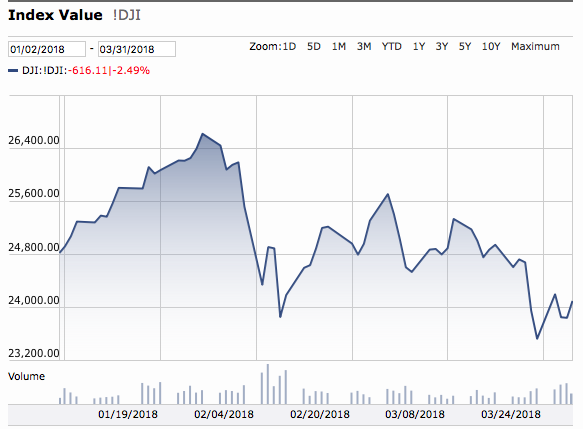Wall Street’s First Quarter Wasn’t as Bad as I Thought
After really digging into the graphs and numbers, it turns out Wall Street’s first quarter wasn’t as bad as I thought.
Which is one of the reasons why I write up these quarterly updates.
When you watch the news or read the headlines, the overall movement of the markets gets lost in the significant ups and downs that are reported day-to-day.
When you’re able to let the dust settle and really look at the longer-term trends, you get a much better feel for where the markets have been, and, potentially, where they may be headed.
That said, let’s look at those 2018 Q1 charts and return numbers.
2018 First Quarter Returns
The Dow Jones Industrial Average decreased 616.11 points for a percentage loss of 2.49%
While the S&P 500 dropped 31.30 points during the 1st quarter for a percentage loss of 1.17%.
And the Nasdaq actually climbed 161.04 points for a percentage increase of 2.33%.
Why It Seemed So Bad
The first quarter of 2018 seemed so bad because there were significant gyrations in all the major markets. A quick glance at the three charts above can confirm that.
Once the markets hit the latter part of January, it was roller-coaster city from then on.
Only recently have the markets cooled their wild ups and downs.
But, as I mentioned, when all was said and done, the percentage losses really weren’t that bad. And, in fact, the Nasdaq posted a decent gain for the period. Ahhh those tech stocks, gotta love ’em.
Why the Volatility
As with most things, there really isn’t a simple answer to why we’re now seeing volatility in markets that, heretofore, have been on a steady, unchecked, upward climb.
During the first quarter, we saw some international matters that gave the markets pause…think North Korea and the potential tariffs that could negatively impact some U.S. businesses.
And don’t discount traders’ actions when viewing these day-to-day market swings. For quite a while now, traders have really had to search out stocks that are priced such that they’ll give a decent short-term gain. When stocks just march up and up, finding a good place to jump in can be difficult.
But, when stocks take a 3-5% hit because Kim Jong Un fired another rocket, traders rush in, buying on that dip, causing stocks to jump the next day, at which time they take their profits and, bam, the selling leads to a down market the next day.
I’m not saying traders were the cause of the market fluctuations, but they were involved.
Finally, economic indicators also weighed on the markets. Specifically, increases in interest rates.
If you haven’t been paying attention, the Federal Reserve increased interest rates a quarter percent this past March and has signaled it will likely increase two more times before the end of 2018.
This is welcome news on one hand since it shows a more “normalizing” of interest rates. For far too long, interest rates have been kept well-below historical norms.
On the other hand, increased interest rates will mean mortgages, car loans, credit cards (when a balance is kept) and any other payment-type system tied to interest rates, will cost more.
The higher the interest rates go, the more it’ll cost you and me. Which’ll leave less money for consumers to spend on other things, potentially, hitting businesses in a negative way.
The one major negative – of which most Americans are unaware – associated with higher interest rates, and which may have spooked the markets most, pertains to the U.S.’s debt payments.
When interest rates rise, so too does the amount of interest the federal government must pay to those purchasing U.S. bonds.
And with over $20 trillion in outstanding debt and a deficit that is predicted to do nothing but grow, interest payments on that debt will begin to really impact the federal budget.
I’ve written extensively on the U.S. debt and deficit problem in other forums. Most of the time, my warnings fall on disinterested ears.
And who can blame people, when our elected officials act as if there is no fiscal problem at all. If only that were true.
But, you do see the markets taking notice, which is partly why we see these up and down movements when interest rates are in the news.
It’s just that other factors then take over – corporate earnings, current economic indicators, etc. – and the markets move on…for now.
Wrap Up
The 2018 first quarter saw market volatility, that’s for sure. Overall, though, it wasn’t too bad.
It is worth keeping in mind, however, that markets just do not behave as they have these last nine or so years. They don’t climb without taking a break here and there…unless they’re artificially inflated.
Take a quick look at one of my previous quarterly updates Have You Been Riding the Stock Market Rocket Ship? in which I present a few bull/bear market stats to illustrate how long increasing markets usually maintain that momentum.
The stats in that piece are partly why I would not have been surprised to see significantly greater losses this past quarter…or to see larger downturns in quarters to come.
Only time will tell.
Until then…here’s my typical sign-off blurb.
We at Savings Beagle are not investment advisors. It’s not our goal to encourage you to put your money into the markets, or to sell if you already have invested.
Rather, it’s to provide information to help illustrate the current state of the U.S. markets which can help guide your financial decisions.
Saving money – whether by investing in stocks, bonds or by simply putting a set amount into a savings account on a regular basis – is critical to your future financial well-being.
And we’re here to relay money saving deals and tips to make finding that excess cash that you can put to work a little easier.
If you haven’t already, bookmark our site, follow us on Facebook, join us on Twitter or subscribe to our posts to ensure you receive every savings opportunity we’re able to pass along.
Saving money and planning for the future’s hard – we’re here to help make it a little easier.
charts courtesy of morningstar.com






